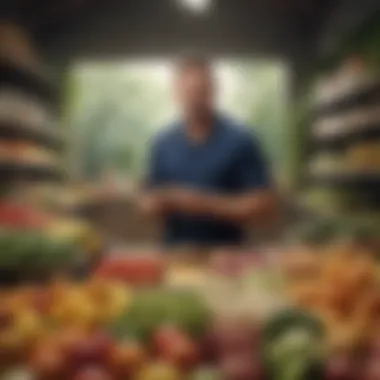Essential Foods for Hurricane Preparedness


Intro
Topic Overview
Definition and Importance
Hurricane preparedness encompasses various strategies to minimize the impact of such natural disasters. Food selection is a vital component, as access to nutritious and safe food can determine how well individuals cope during and after a storm. Non-perishable food items are crucial since they can be stored for long periods without spoilage. Stocking up on these items helps ensure that families remain nourished and healthy when fresh supplies are unavailable.
Brief History and Evolution
Historically, communities in hurricane-prone regions have relied on non-perishable food for emergency situations. Canned goods, dried fruits, grains, and other shelf-stable products have long been staples in storm preparation. Over time, food technology has advanced, allowing for better preservation techniques. Innovations such as vacuum sealing and freeze-drying have expanded the variety of foods available for long-term storage.
Essential Considerations
Selecting food items for hurricane preparedness goes beyond just choosing items with long shelf lives. Considerations include dietary needs, ease of preparation, and water requirements. It is essential to include a mix of carbohydrates, proteins, and fats to ensure balanced nutrition. Non-perishable items like peanut butter, nuts, canned beans, and whole grain cereals provide valuable sustenance.
Additionally, taking into account any dietary restrictions is important. For instance, those who are lactose intolerant or have gluten sensitivities should avoid items containing dairy and gluten respectively. As a rule of thumb, keep in mind the population you are stocking for—children, elderly family members, or individuals with specific health concerns.
Practical Applications
Step-by-Step Guides
- Assess Needs: Identify the number of people in the household and dietary restrictions.
- Choose Non-Perishable Foods: Look for nutrient-dense options that can be stored long-term.
- Plan Storage: Allocate space in a cool, dry place. Ensure items are rotated regularly to avoid spoilage.
- Check Supplies Regularly: Update stock every few months to ensure freshness and relevance to current dietary needs.
Case Studies or Real-World Examples
Communities that have faced hurricanes such as Hurricane Katrina and Hurricane Sandy provide valuable lessons in food preparedness. Many residents struggled to access food during these disasters. Those who had prepared adequately with non-perishable items fared better. Disaster response programs often emphasize the importance of individual preparedness and community-level food resilience. Successful case studies show that individuals who planned ahead could maintain better health and comfort during the recovery period.
"Preparedness is not an option; it is a necessity for survival during hurricanes."
By understanding food selection and its implications during emergencies, individuals can ensure their well-being during these trying times.
Understanding the Importance of Food Preparedness
Hurricane preparedness is not merely a logistical task; it is a critical component of ensuring the health and safety of individuals and communities. The need for a well-thought-out food supply during such natural disasters becomes paramount. Preparing your food supplies in advance reduces panic and provides a sense of security. An adequate food stock can mean the difference between survival and discomfort.
Understanding what food to store can alleviate the stress that comes during a storm’s aftermath. Access to nutrition impacts overall health, and timely intake during emergencies can prevent serious health issues. For both urban and rural settings, accessibility to food supplies can be compromised. Therefore, having the right kinds of food at hand is vital.
Why Food Supply Matters During Hurricanes
During hurricanes, supply chains can be severely disrupted. Grocery stores may run out of essentials quickly as people rush to prepare, leaving many without critical items. Stocking up on food supplies ensures families are fed, even when accessing stores becomes impossible due to flooding or debris.
The right food choices are essential not just for sustenance but also for maintaining morale. Having familiar and comforting foods can make uncertain times easier to cope with. Furthermore, food supplies should meet the nutritional needs of all family members, which includes incorporating vitamins and proteins.
- Key elements to consider include:
- Long shelf-life options that do not require refrigeration
- Nutritional balance to support immune function
- Ease of preparation under difficult conditions
By choosing wisely, one can decrease reliance on external sources of food, which may be inaccessible in the wake of a storm.
Impacts of Hurricanes on Food Accessibility
The impacts of hurricanes extend beyond immediate environmental damage. They disrupt local economies and can cut off distribution networks needed for food supplies. Access to local farms may also be hindered due to flooded fields or damaged property, impacting the availability of fresh produce.
In such situations, communities may face:
- Food shortages, leaving less time to gather necessary essentials.
- Increased prices on remaining supplies due to scarcity, which may affect those with limited resources.
- Changes in food quality, as emergency supplies may not uphold the same standards, leading to reliance on unsuitable substitutes.
"Planning ahead for food supplies mitigates these risks and ensures that individuals can maintain a level of food security during crises."
Food accessibility in emergencies highlights the need not just for individual supplies but also community readiness. People must work together to create a supportive network, sharing resources and knowledge on how to prepare effectively for hurricane seasons.


Preparedness is not merely concerned with stocking food but rather creating an informed community that understands the relevance of having a food plan in place before disaster strikes.
Non-Perishable Food Options
When preparing for hurricanes, selecting non-perishable food options is vital. These foods can last for long periods, making them suitable for emergencies. Non-perishable items require minimal attention for storage, which is crucial when facing potential disaster and uncertainty. Maintaining a stock of such foods ensures that you and your family have sufficient nutrition during extended outages of power and access to fresh supplies.
Canned Goods: A Reliable Source
Canned foods are a pillar of non-perishable options. They are durable, easy to store, and offer a variety of choices. Common types include vegetables, fruits, meats, and soups. This variety allows individuals to create balanced meals even in challenging circumstances.
Types of Canned Foods
Canned foods come in many forms, including whole, diced, or even pureed. Each type contributes uniquely to meal planning. For example, canned tomatoes can enhance sauces and soups, whereas canned beans provide an excellent source of protein. Their versatility makes them suitable for various culinary preferences and dietary needs. One key characteristic is the ease of use. They can be consumed directly after opening, making a quick meal possible. However, one should also be aware of the possibility of high sodium content in some canned products, which can affect health.
Benefits of Canned Foods
Canned foods offer significant benefits, including convenience and long shelf life. They are often ready-to-eat, requiring little to no preparation. This aspect is helpful during emergencies when cooking facilities may not be available. They also can be relatively inexpensive compared to fresh products, which may not be available during a hurricane. The downside could be the lack of fresh flavors; canned foods may not appeal to everyone.
Storage and Shelf Life
Understanding the storage of canned goods is essential. Canned foods can typically last for several years if stored properly in a cool, dry place. The sealing process used in canning helps prevent spoilage, but it is crucial to check expiration dates and look for cans that are not bulging or leaking. Proper storage can maximize their longevity. However, once opened, they should be consumed or refrigerated and used within a few days to ensure safety and quality.
Dry Foods: Versatile and Long-Lasting
Dry foods also serve as essential staples in hurricane preparedness. They include items like grains and pasta, legumes, and dehydrated meals. Their dry nature makes them lightweight and easy to handle. This convenience is particularly advantageous during emergencies when mobility may be limited.
Grains and Pasta
Grains and pasta provide substantial energy through carbohydrates. Options like rice, quinoa, and various types of pasta are long-lasting and filling. They make excellent bases for any meal and pair well with various other foods like canned vegetables or proteins. One key characteristic of grains and pasta is their ability to absorb flavors, enhancing the overall meal experience. One disadvantage, however, is their cooking requirement; running water or heating may be unavailable during a hurricane.
Legumes and Beans
Legumes, such as lentils and chickpeas, are powerhouses of nutrition. They offer protein, fiber, and essential nutrients. They are versatile, allowing for inclusion in a variety of dishes from soups to salads. A notable advantage of legumes and beans is their long shelf life when dried. A potential drawback is their preparation process; they often require soaking and cooking, necessitating several hours to prepare.
Dehydrated Meal Options
Dehydrated meals represent a modern solution to emergency food supplies. These meals can include anything from soups to full entrees. Their primary benefit is portability; they are lightweight and easy to transport. In addition, they can provide a hearty meal with minimal preparation required. However, their dependence on water for rehydration can be a disadvantage, especially when access to clean water is limited. It's crucial to consider these factors when selecting meals for emergency supplies, as they might not accommodate every situation.
In summary, non-perishable food options, including canned goods and dry foods, are essential during hurricane preparedness.
This careful selection guarantees that sustenance is available even in times of uncertainty.
Nutritional Considerations
Food not only sustains life but also supports overall health, especially during crises like hurricanes. In such situations, maintaining proper nutrition becomes paramount. Nutritional considerations focus on the macronutrients and micronutrients necessary for optimal functioning. These nutrients help to ensure strength, endurance, and immunity when faced with stressors associated with natural disasters.
Balancing Macronutrients
Proteins
Proteins play a crucial role in maintaining muscle mass and repairing tissues. They are made up of amino acids, some of which are essential, meaning they must be obtained through diet. In a hurricane scenario, incorporating protein sources is vital because they provide the energy needed for daily activities and recovery. Canned tuna, beans, and lentils are excellent choices because they have extended shelf lives. The main advantage of proteins is their ability to satisfy hunger while promoting tissue healing and immune function. However, they must be stored properly to avoid spoilage.
Fats
Fats are often overlooked but are essential for providing energy and facilitating the absorption of fat-soluble vitamins A, D, E, and K. Healthy fats can be sourced from items such as olive oil and nut butters. They are energy-dense, meaning a small quantity can offer substantial calories. Thus, they can be a beneficial option for emergency food stocks. A significant advantage of fats is their long shelf life when stored in appropriate conditions. However, it is critical to be mindful of portion sizes since fats are high in calories.
Carbohydrates
Carbohydrates are the body's primary energy source. They can be found in grains, bread, and pasta, all of which are staples in any emergency prep plan. These foods are relatively easy to store and prepare. Carbohydrates also provide fiber, which supports digestive health. This nutrient is particularly beneficial in sustenance plans aimed at keeping energy levels stable during stressful times. Care, however, should be taken with refined carbohydrates which can be less nutritious than whole grains.
Essential Vitamins and Minerals


Vitamins and minerals are vital for numerous bodily functions, especially under stress. They support metabolic processes, promote healing, and enhance immune responses, which can be significantly slowed during emergencies.
Micronutrient Sources
Micronutrients can be found in a variety of foods, including canned vegetables, fruit, and fortified grains. These foods can provide necessary nutrients to fend off deficiencies that might arise from limited food options during emergencies. For example, canned spinach can offer iron, while fortified cereals can provide a range of essential B vitamins. Their major advantage is that they contribute to overall wellness and can be stored for long periods. It is crucial, however, to choose options lower in sodium or sugar.
Boosting Immunity
Strengthening the immune system is essential during emergencies when health risks can increase. Foods rich in vitamin C, like canned citrus fruits, and zinc from sources like canned beans can bolster immune responses effectively. Another effective strategy is to include garlic and ginger, known for their health benefits. The unique feature of focusing on immunity is that it empowers individuals to remain healthier during challenging times. The downside could be the availability of fresh produce, which tends to deteriorate more quickly.
"A well-balanced diet is more than just a necessity; it is a critical foundation for health, particularly in preparation for unpredictable challenges."
In summary, careful attention to nutrition will ensure that individuals and communities are well-prepared to face hurricanes and their aftermath. By understanding the importance of various nutrients, one can make informed decisions when stockpiling essential food supplies.
Hydration Needs During Emergencies
During a hurricane or any natural disaster, ensuring adequate hydration is crucial for maintaining health and survival. Access to clean water not only supports physical functions but also helps to prevent dehydration-related illnesses. Therefore, planning for hydration in advance is essential. This section will explain how to effectively store water and the best ways to ensure its quality, along with alternatives to drinking water that can also aid in hydration.
Water Storage and Quality
How Much Water to Store
In an emergency, knowing how much water to store is vital. The general guideline is to store at least one gallon per person per day. This amount accounts for drinking, cooking, and basic hygiene needs. For a family of four, this means preparing at least 16 gallons for a week. This specific aspect of hydration is a simple yet effective measure. Storing an adequate supply of water is one of the most beneficial steps in emergency preparedness. The unique feature of this guideline is its practicality; it allows individuals and families to plan simple yet effective strategies for staying hydrated. Having enough water can prevent panic during a crisis, hence providing peace of mind.
Water Purification Methods
The purification of water becomes necessary when supplies may be contaminated. Methods such as boiling, filtration, and using purification tablets can ensure the water's safety. Each of these methods has unique advantages. Boiling is straightforward and requires minimal equipment. Filtration can improve taste and remove impurities, while tablets are lightweight and easy to store. In a hurricane scenario, understanding these methods is beneficial. While boiling takes time, filtering may not eliminate all pathogens depending on the filter used. It’s important for individuals to familiarize themselves with these techniques beforehand, making sure they know how to secure safe drinking water in case of an emergency.
Hydration Alternatives
Electrolyte Drinks
Electrolyte drinks can supplement hydration needs during emergencies, especially if there is physical exertion involved. These beverages replenish lost minerals and help maintain electrolyte balance. The key characteristic of electrolyte drinks is their formulation, often rich in sodium, potassium, and other essential minerals. This makes them a popular choice when standard water may not be enough. The unique feature of these drinks is that they not only hydrate but also energize. However, they often contain sugars and calories that may not be ideal for everyone. Understanding when and how to use electrolyte drinks can provide an added layer of hydration strategy.
Food with High Water Content
Incorporating food with high water content is another effective way to stay hydrated during emergencies. Fruits like watermelon and vegetables like cucumbers can contribute significantly to hydration. The key benefit of these foods is that they deliver fluids along with essential vitamins and minerals. Having such foods on hand is both a beneficial and practical choice in meal planning. However, these items are perishable and should be consumed early in any stored supply. Balancing perishable foods with non-perishables can enable a flexible approach to hydration needs during a hurricane.
Alternative Energy Sources for Cooking
In the context of hurricane preparedness, securing alternative energy sources for cooking is critical. Power outages are common during and after severe weather events, thus creating a reliance on non-traditional cooking methods becomes essential. These energy sources can help ensure that families maintain their nutrition during emergency situations.
Alternative cooking methods provide flexibility and versatility. They also support the need for continuous meal preparation, which is crucial when access to fresh food is limited. Utilizing alternative energy makes it easier to cook meals with the supplies you’ve stored, ensuring that food can be safely consumed.
Portable Cooking Devices
Camping Stoves
When power is unavailable, camping stoves emerge as a prime choice for cooking. These compact devices deliver a reliable heat source and are easy to transport. They typically use propane canisters or liquid fuel, which can be durable and long-lasting.
One key characteristic of camping stoves is their simplicity. They often feature adjustable heating controls, allowing for precise temperature management. This makes them a beneficial option for those looking to prepare various meals, from boiling water to simmering stews. A unique feature of camping stoves lies in their fast heating capabilities, which significantly reduce cooking time.
Advantages of these stoves include portability and ease of use. However, safety considerations should not be overlooked. Proper ventilation must be ensured, as these stoves can produce potentially harmful fumes when used indoors.
Solar Cookers
Solar cookers also play a valuable role in alternative cooking methods. They convert sunlight into heat, making them a sustainable option. These devices can operate effectively in sunshine, meaning they’re most useful in regions with stable weather before a hurricane.
The distinctive characteristic of solar cookers is their ability to work without any fuel. This makes them a low-cost and environmentally friendly choice during emergencies. They can effectively cook, bake, or even pasteurize water. However, the effectiveness of solar cookers can be significantly affected by climate conditions and the time of day, limiting their usability.
The primary advantage of solar cookers is their sustainability, as they rely solely on sunlight. Conversely, they may not be suitable in prolonged periods of cloudy weather or after a hurricane when conditions can be unpredictable.


Food Safety on Alternative Heat Sources
Ensuring food safety while using alternative heat sources is paramount. First, always follow manufacturer guidelines for your cooking devices, as these instructions often dictate safe cooking practices. Secondly, inspect your food supplies prior to cooking. Canned goods or dried products should be checked for damage or spoilage before use.
"Prioritizing food safety in emergencies can prevent foodborne illnesses that pose risks during stressful situations."
Meal Planning Strategies
Planning meals in advance plays a critical role during hurricane preparedness. Having a structured approach to meal planning ensures that individuals can access nutritious food while minimizing waste and the stress associated with sudden emergencies. The ability to create meal plans not only guarantees dietary needs are met but also enhances overall resilience in these trying times. Below are key elements related to this concept.
Creating Simple Meal Plans
Creating simple meal plans is fundamental for anyone looking to prepare for a hurricane. Start by evaluating your current food supply and assess what non-perishable items are available. Focus on foods that have long shelf lives and require minimal cooking, as power outages are common during hurricanes. A good practice is to include staples like rice, canned vegetables, and protein sources. Here’s how to approach this task:
- List Essential Ingredients: Identify items that can form the basis of multiple meals, such as grains, beans, and protein sources.
- Consider Meal Combinations: Combine ingredients to create balanced meals. For example, a can of beans can be used with rice and vegetables.
- Estimate Portion Sizes: Calculate the amount of each ingredient you need based on the number of people in your household and their dietary preferences.
- Prepare a Schedule: Assign specific meals to each day, ensuring variety and nutritional balance throughout the week. This structure can help avoid confusion and food fatigue during emergencies.
Incorporating Variety to Prevent Fatigue
Sticking to the same foods can lead to meal fatigue, especially in stressful situations like hurricanes. It is vital to keep meals interesting, which can be achieved through variety. Here are some strategies to incorporate diversity into your meal plans:
- Rotate Ingredients: Use different grains and legumes each week. For instance, alternate between quinoa, rice, and pasta.
- Explore Flavor Profiles: Keep various spices and herbs on hand to help transform simple meals. Different seasoning can change the perception of the same basic ingredients.
- Mix Cooking Methods: Although cooking may be limited during emergencies, consider preparing some foods using different methods. For example, grilled vegetables can provide a different taste compared to steamed.
- Diversify Snacking Options: Snacks can also play a role in variety. Include items like trail mix, nut butter, and dried fruits to provide a range of textures and flavors.
- Utilize Canned Goods Creatively: Different types of canned goods can be combined to create unique dishes. For example, canned tuna can be mixed with canned corn and mayonnaise for various easy meals.
Remember: Planning can mitigate the stress of unexpected situations. Meal planning strategies empower individuals and families to stay nourished even in times of crisis.
Special Dietary Considerations
When preparing for potential hurricane disruptions, attention to dietary needs can greatly impact well-being. Special dietary considerations require careful planning to ensure that all individuals receive the essential nutrients they need to thrive during emergencies. This consideration is particularly relevant for groups with unique nutritional requirements, such as those with food allergies, infants, and elderly individuals.
Food allergies can pose serious health risks during emergencies, making it essential to accommodate them in meal planning. Understanding which common allergens to avoid is critical. Common allergens include dairy, peanuts, tree nuts, eggs, soy, wheat, fish, and shellfish. During a hurricane, food availability may be limited, increasing the chances of purchasing or consuming foods that could trigger allergic reactions. It is wise to stock up on allergen-free substitutes, such as almond milk instead of cow's milk, and gluten-free grains like quinoa or rice. Careful label reading can prevent complications during emergencies.
Additionally, nutritional needs vary significantly for infants and the elderly. Infants require specific formulas or baby foods created to meet their growth and development needs. Common choices include hypoallergenic formulas, rice cereal, and pureed fruits and vegetables. Ensuring an adequate supply of these items reduces stress in a crisis.
Elderly individuals often have dietary restrictions based on health conditions. They may need low-sodium options or foods high in fiber. Incorporating good sources of nutrition, like beans and oats, can help maintain digestive health. Here are key considerations for special dietary needs:
- Food Allergies: Stock up on allergen-free alternatives.
- Infants: Focus on baby formuls and pureed foods.
- Elderly: Choose foods that cater to dietary restrictions, such as low-sodium or high-fiber items.
"Planning for special dietary needs ensures that everyone, regardless of age or health status, can maintain a proper diet during challenging times."
By anticipating these dietary needs, one can establish a comprehensive hurricane food plan that addresses the diverse requirements of all family members. This proactive approach minimizes risks and enhances preparedness efforts.
Community Preparedness Efforts
Community preparedness is a vital component in the face of natural disasters such as hurricanes. While individuals can make significant strides in their personal readiness, the collective actions of communities amplify these efforts. This section delves into the importance of community engagement and local resources in ensuring food accessibility during emergencies.
A well-prepared community can mitigate risks associated with food shortages. When individuals collaborate and share resources, they foster a strong support network. This approach not only enhances the overall efficiency of resource distribution but also addresses the nutritional complexities that can arise post-hurricane. Different members of a community can provide unique insights into local food needs, disability considerations, and logistical capabilities, all of which contribute to a more robust preparedness plan.
Moreover, communities that engage in preparedness efforts often foster a culture of resilience. This culture can lead to proactive solutions such as establishing local food banks, communal gardens, and emergency nutrition plans that utilize locally available resources. These initiatives serve as a safety net during crises and build long-lasting relationships among community members.
Local Food Banks and Resources
Local food banks play an essential role in hurricane preparedness efforts. They act as key providers of emergency food supplies. During a hurricane, regular food access can be severely disrupted. Food banks help to bridge this gap by offering non-perishable foods, crucial for survival and nutrition during and after a disaster. Awareness of local food banks is essential so that individuals and families can turn to them when needed.
Most food banks collaborate with local farmers and businesses in their regions, creating mutual support systems. These partnerships enable consistent food supplies. Additionally, food banks often have programs designed to assist those with special dietary needs, which is especially important in emergencies.
It is vital for communities to foster relationships with their local food banks. This can be done through volunteering, fundraising, or providing donations. A strong connection ensures that food banks are equipped and ready to serve their communities in times of crisis. Here are important points to consider regarding food banks:
- Accessibility: Ensure food banks are accessible to everyone, including those with mobility challenges.
- Awareness Campaigns: Conduct outreach efforts to educate the public about available resources.
- Collaboration with Local Producers: Work with local farmers to stock food items relevant to the community's needs.
Collaborative Approaches for Nourishment
Collaboration within communities leads to innovative solutions for food availability during hurricanes. When individuals, local businesses, and organizations work together, they can enhance food security and create impressive support networks. Establishing collaborative approaches fosters a sense of shared responsibility and inclusiveness.
Community forums and workshops are great places to identify and address local food needs. Engaging discussions can reveal critical insights into potential food shortages and strategies for mitigation. Involving diverse community members ensures that all voices are heard, leading to more effective preparedness strategies.
Strategic planning can take various forms, such as:
- Community Cooking Events: These events can help disseminate food preparation tips and encourage the use of non-perishable items effectively.
- Local Produce Swaps: Encouraging neighbors to exchange surplus items fosters community ties and reduces waste.
- Setting Up Response Teams: Designating groups within the community for quick relief distribution can improve the efficiency of food delivery during a disaster.
Building a collaborative framework strengthens community ties, making recovery from disasters more manageable and ensuring that everyone has access to the necessary resources.



